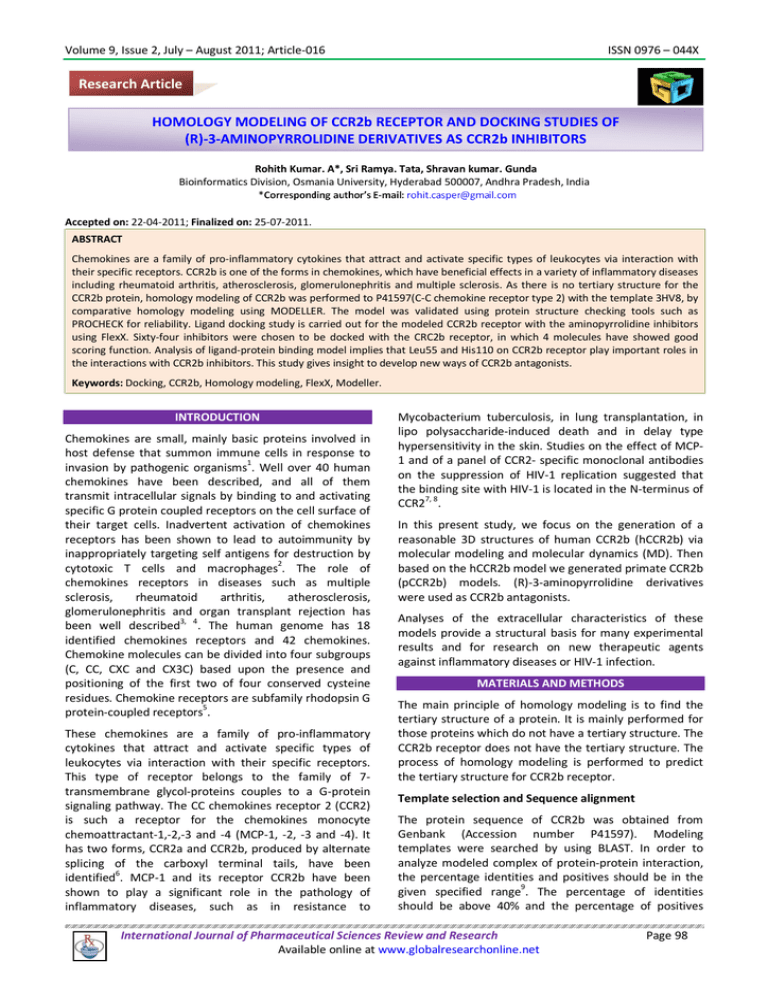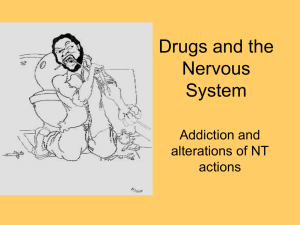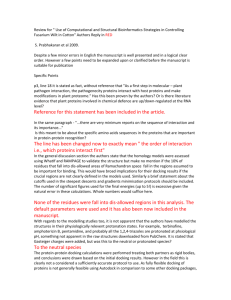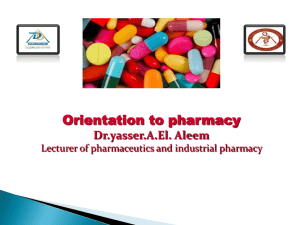Document 13308632
advertisement

Volume 9, Issue 2, July – August 2011; Article-016 ISSN 0976 – 044X Research Article HOMOLOGY MODELING OF CCR2b RECEPTOR AND DOCKING STUDIES OF (R)-3-AMINOPYRROLIDINE DERIVATIVES AS CCR2b INHIBITORS Rohith Kumar. A*, Sri Ramya. Tata, Shravan kumar. Gunda Bioinformatics Division, Osmania University, Hyderabad 500007, Andhra Pradesh, India Accepted on: 22-04-2011; Finalized on: 25-07-2011. ABSTRACT Chemokines are a family of pro-inflammatory cytokines that attract and activate specific types of leukocytes via interaction with their specific receptors. CCR2b is one of the forms in chemokines, which have beneficial effects in a variety of inflammatory diseases including rheumatoid arthritis, atherosclerosis, glomerulonephritis and multiple sclerosis. As there is no tertiary structure for the CCR2b protein, homology modeling of CCR2b was performed to P41597(C-C chemokine receptor type 2) with the template 3HV8, by comparative homology modeling using MODELLER. The model was validated using protein structure checking tools such as PROCHECK for reliability. Ligand docking study is carried out for the modeled CCR2b receptor with the aminopyrrolidine inhibitors using FlexX. Sixty-four inhibitors were chosen to be docked with the CRC2b receptor, in which 4 molecules have showed good scoring function. Analysis of ligand-protein binding model implies that Leu55 and His110 on CCR2b receptor play important roles in the interactions with CCR2b inhibitors. This study gives insight to develop new ways of CCR2b antagonists. Keywords: Docking, CCR2b, Homology modeling, FlexX, Modeller. INTRODUCTION Chemokines are small, mainly basic proteins involved in host defense that summon immune cells in response to invasion by pathogenic organisms1. Well over 40 human chemokines have been described, and all of them transmit intracellular signals by binding to and activating specific G protein coupled receptors on the cell surface of their target cells. Inadvertent activation of chemokines receptors has been shown to lead to autoimmunity by inappropriately targeting self antigens for destruction by cytotoxic T cells and macrophages2. The role of chemokines receptors in diseases such as multiple sclerosis, rheumatoid arthritis, atherosclerosis, glomerulonephritis and organ transplant rejection has 3, 4 been well described . The human genome has 18 identified chemokines receptors and 42 chemokines. Chemokine molecules can be divided into four subgroups (C, CC, CXC and CX3C) based upon the presence and positioning of the first two of four conserved cysteine residues. Chemokine receptors are subfamily rhodopsin G protein-coupled receptors5. These chemokines are a family of pro-inflammatory cytokines that attract and activate specific types of leukocytes via interaction with their specific receptors. This type of receptor belongs to the family of 7transmembrane glycol-proteins couples to a G-protein signaling pathway. The CC chemokines receptor 2 (CCR2) is such a receptor for the chemokines monocyte chemoattractant-1,-2,-3 and -4 (MCP-1, -2, -3 and -4). It has two forms, CCR2a and CCR2b, produced by alternate splicing of the carboxyl terminal tails, have been 6 identified . MCP-1 and its receptor CCR2b have been shown to play a significant role in the pathology of inflammatory diseases, such as in resistance to Mycobacterium tuberculosis, in lung transplantation, in lipo polysaccharide-induced death and in delay type hypersensitivity in the skin. Studies on the effect of MCP1 and of a panel of CCR2- specific monoclonal antibodies on the suppression of HIV-1 replication suggested that the binding site with HIV-1 is located in the N-terminus of CCR27, 8. In this present study, we focus on the generation of a reasonable 3D structures of human CCR2b (hCCR2b) via molecular modeling and molecular dynamics (MD). Then based on the hCCR2b model we generated primate CCR2b (pCCR2b) models. (R)-3-aminopyrrolidine derivatives were used as CCR2b antagonists. Analyses of the extracellular characteristics of these models provide a structural basis for many experimental results and for research on new therapeutic agents against inflammatory diseases or HIV-1 infection. MATERIALS AND METHODS The main principle of homology modeling is to find the tertiary structure of a protein. It is mainly performed for those proteins which do not have a tertiary structure. The CCR2b receptor does not have the tertiary structure. The process of homology modeling is performed to predict the tertiary structure for CCR2b receptor. Template selection and Sequence alignment The protein sequence of CCR2b was obtained from Genbank (Accession number P41597). Modeling templates were searched by using BLAST. In order to analyze modeled complex of protein-protein interaction, the percentage identities and positives should be in the 9 given specified range . The percentage of identities should be above 40% and the percentage of positives International Journal of Pharmaceutical Sciences Review and Research Available online at www.globalresearchonline.net Page 98 Volume 9, Issue 2, July – August 2011; Article-016 must be above 60%. The sequence of the most identical sequence called template is selected and the coordinate file is taken from the protein data bank (PDB ID: 3HV8). Then all the hetero atoms are deleted from the file and the FASTA sequence of both the query (P41597) and the template (3HV8) are taken from the NCBI databank and the sequences are subjected to pair wise alignment using Clustal-X. The pair wise alignment of the query and template is shown in Figure 1. ISSN 0976 – 044X protein pockets by solvating the structure to locate regions where solvent-spheres tend to cluster. Figure 2: Ramachandran plot of P41597.B99990014 obtained by PROCHECK. The most favored regions are colored red, additional allowed, generously allowed and disallowed regions are indicated as yellow, light yellow and white fields, respectively. Docking studies Figure 1: Sequence alignment between human CCR2b and the protein 3HV8 obtained by the pair wise global sequence alignment program using CLUSTAL-X. Model building: Evaluation and Validation Molecular structures of CCR2b receptor were modeled by using restraint-based modeling implemented in the program MODELLER 9v710. Twenty models of CCR2b have been generated by MODELLER. Finally, the structure having the least RMSD of Cα trace (P41597.B99990014) generated during the molecular dynamics was used for further studies. In this step, the quality of the initial model was improved. The quality and stereochemistry of the models were evaluated using the program PROCHECK11. The final model was selected based on stereochemical quality. The torsion angles of φ and ψ in the generated models are represented in Ramachandran plot as shown in Figure 2. The main-chain conformations for 93.7% amino acid residues were within the favored regions, 5.99% amino acid residues were in allowed regions of the Ramachandran plot. The overall G-factor is a measure of the overall normality of the structure and low G-factors indicate that residues have unlikely conformations. The selected model was then refined by energy minimization by 10 steps of conjugate gradient minimization until the energy gradient RMS was <0.05 kcal (mol A)-1. Structural models were visualized by PyMol molecular graphics system. The binding pockets of hCCR2b were identified using Site ID, a program for identifying and characterizing protein active sites, binding sites and functional residues located on protein surfaces. It is also used for identifying Docking studies were carried out using the FlexX12 program interfaced with SYBYL 6.713. In this automated docking program, the flexibility of the ligands is considered while the protein or biomolecules is considered as a rigid structure. The ligand is built in an incremental fashion, where each new fragment is added in all possible positions and conformations to a preplaced base fragment inside the active site. All the molecules for docking were sketched in the SYBYL and minimized using Tripos force field with Gasteiger-Hückel charges using conjugate gradient method. The 3D coordinates of the active sites were taken from the homology build hCCR2b model reported as complex with the corresponding sixty-four antagonists. The active site was defined as the area within 6.5Å around the cocrystallized ligand, formal charges were assigned to all the molecules and FlexX run was submitted. RESULTS AND DISCUSSION Structure validation The 3-D structure of hCCR2b was built by homology modeling based on the template obtained from protein data bank. The φ and ψ angles are represented by Ramachandran plot. Altogether 100 per cent of the residues were in the favored and allowed regions. The profile score above zero in the VERIFY-3-D14 graph corresponded to acceptable environment of the model. The Ramachandran plot contributed final values of hCCR2b i.e. 93.7% of residues in most favored regions. The allowed regions in additional residues of 5.9%, generously allowed regions were 0.4%. Non-proline International Journal of Pharmaceutical Sciences Review and Research Available online at www.globalresearchonline.net Page 99 Volume 9, Issue 2, July – August 2011; Article-016 ISSN 0976 – 044X residues, non-glycine residue regions were 100.0% and most disallowed regions were 0.0% in the plot. Docking In the present study, to understand the interactions between the hCCR2breceptor and its inhibitors and to explore their binding mode, docking study was performed using FlexX of receptor-ligand interactions section available under SYBYL6.7. Docking studies yielded crucial information concerning the orientation of the inhibitors in the binding pocket of the receptor. The ligand-protein interaction analysis shows that Ile83, Ala80, His110, Leu55, Val87, Leu71, Ala74, Lys75and Ser112 are the important residues present at the active site and are the main contributors to the receptor-ligand interactions. It has been observed that, for better CCR2b inhibitory activity, for amino acid residues (Val53, Leu55, His110 and Leu111) should optimally interact with the substituted aminopyrrolidine derivatives. Sixty-four compounds with their structure and their docking scores are given in the Table 1. Table 1: Sixty-four aminopyrrolidine derivatives with their structures and docking score Comp. No. 1 2D structure O N F H N N H Dock score -14.7 Comp. No. 33 2D structure O N F F O N Cl -14.1 F 34 F F F O N F F O O N H N H -15.7 F H N N H O H 35 NH2 F F F F F O N O NH2 O 4 HH H O N O F H N N H -14.2 36 F F F O O N F F NH2 O 5 H H -13.4 H O N F F F O F H N N H 37 O N F F NH2 O H H 6 -13.5 H O N 38 Cl F F 7 H O N F H N N H N H 39 F F 8 -16.1 N N H F O F H N N H -13.2 41 N H NH2 F F F O F F O N H2 N NH2 O 10 -13.4 S O N O N F H N N H NH2 O O -13.5 43 F F F F F O O N O NH2 O 12 -15.6 N O N N H 44 N H F F -14.4 N O NH2 F F F Cl F H N N H 45 O N F F Cl O -17.2 H N O H N O N O 13 F F F F H N F O N N H F H N -21.5 46 C l -17.0 H N N H NH2 O 14 -15.2 H N N H O H -17.7 H N N H O 11 O N O F F F F F O F H N N H 42 -16.7 H N N H O -15.3 H N O Br N O N H2N F F F O O 9 NH2 F F H N N H 40 -16.8 H N O H H O O N O H NH2 F F F H2N -11.2 H N O -15.5 O H O N H 2N O H F F F F H N N H -12.9 H N N H O -15.0 H N N H O -18.2 H N N H H -16.5 H N O 3 Dock score -21.7 N H2 O H N N H F H N N H O 2 F F -9.3 N N H O O F F O International Journal of Pharmaceutical Sciences Review and Research Available online at www.globalresearchonline.net Page 100 Volume 9, Issue 2, July – August 2011; Article-016 Comp. No. 15 2D structure Dock score -21.5 O2N O N F H N N H ISSN 0976 – 044X Comp. No. 47 2D structure O N F F N H O 16 -13.5 H O N H 17 H H 48 -10.2 N F H N N H N H O H H Dock score -13.6 Cl C N H N H l O F F O O Cl O N N H Cl F H N -16.7 49 -12.3 N C N H N H O l O F F O F F F HO 18 O N O H N N H -17.5 F 50 -13.7 N C N H N H l O F F O O F F F 19 O N N H -17.5 F H N 51 O F F O O N H Cl Cl 20 O N -13.6 H N N H 52 -11.3 N O O O O N -14.2 H N N H N H Cl Cl 21 -11.6 N 53 N H -17.4 N O Cl O H N N H Cl O Cl 22 O N -13.6 H N N H 54 O F O Cl -14.3 O N H N N H H N N H Cl O 23 -13.1 N 55 -17.7 N O Br H N N H Cl F O O 24 Cl O N -18.1 H N N H 56 -13.5 O F H N N H Cl F F O 25 Cl O N H N N H -16.6 57 -15.5 58 O -12.5 59 NH2 O 27 Cl Cl O N Br Cl O N O N H 31 N H N H O O N H NH2 F F -11.7 63 -13.4 N O O N H N H NH2 F F H N -21.0 64 -12.5 N O Cl O -12.9 N Cl Br O 62 H N F N O -16.4 O 32 NH N H2 Cl F O -9.1 HN O O Cl N N 61 H N O -16.1 H N Cl F F F N N H Cl -12.5 O Cl H N O N H N N H 30 N H Cl 60 N H2 I O -12.9 O N O Cl N -11.9 O -12.5 O 29 O N H N H H N N H -13.6 Cl N H2 O 28 O N H N N H O N H H N N H F Cl O2N Cl N F O N NO2 O 26 F N O O F N H NH2 International Journal of Pharmaceutical Sciences Review and Research Available online at www.globalresearchonline.net H N F O F F Page 101 Volume 9, Issue 2, July – August 2011; Article-016 ISSN 0976 – 044X Figure 3: (a) Docked conformation of compound 62 (least active molecule) showing important amino acid residue, (b) Docked conformation of compound 44 (most active molecule) showing important amino acid residues, (c) Docked conformation of compound 33 (highest dock score molecule) showing important amino acid residue. In case of compound 62, only one amino acid residue is in close vicinity to the molecule. Due to the substitution of 5-oxo-5-phenyl pentanoyl amide side chain at the R position, the interactions it showed with the receptor are very less. Figure 3(a) shows the interaction distance of 1.764Å between the Leu111 residue and the receptor. This compound is having a very low activity of 4.06, thus the docking score of the compound 62 is also poor (12.9). In compound 44, two hydrogen bonds are formed; one between amino acid Val53 and the oxygen atom of the molecule with an intermolecular distance of 1.634Å, the other hydrogen bond is formed between amino acid His110 and the nitrogen atom present in the aminopyrrolidine core with an intermolecular distance of 2.805Å. These hydrogen bonds help the molecule to fit into the cavity of the receptor. The inhibitory activity (8.49) is very high due to these hydrogen bonds, thus the docking score of this compound is more (-17.2). Figure 3(b) shows the interaction of compound 44 with the amino acids. In compound 33, only one intermolecular hydrogen bond is formed between the oxygen atom of the inhibitory molecule and the amino acid residue Leu55 with an intermolecular distance of 1.82Å. Although the hydrogen bonds help to enhance the binding potential, the bumps disfavor the binding capability and the activity is only of intermediate level (7.698), with a high docking score of -21.7. Figure 3(c) shows the interaction of the molecule with the receptor. leading new ligand interactions. Although, this difference may affect the ligand interaction to some extent, overall similarity of the binding pockets of this protein does not rule out the possibility of development of new inhibitors. Acknowledgment: Authors are thankful to the UGC Govt. of India for financial support. We are thankful to the management of PGRRCDE, Osmania University for providing the software facility and for continuous support to carry out this work. REFERENCES 1. Zlotnik A, Yoshie O. Chemokines: a new classification system and their role in immunity. Immunity, 2000, 12, 121. 2. Cho C, Miller RJ. Chemokine receptors and neural function. J Neurovirol, 2002, 8, 573-584. 3. Gerard G, Rollins BJ. Chemokines and disease. Nat. Immunol. 2001; 2:108. 4. Decvries ME, Ran L, Kelvin DJ. On the edge: the physiological and pathophysiological role of chemokines during inflammatory and immunological responses. Semin Immunol, 1999, 11, 95-104. 5. Belperio JA, Keane MP, Arenberg DA, Addison CL, Ehlert JE, Burdick MD, Strieter RM. CXC chemokines in angiogenesis. J Leukocyte Biol, 2000, 68, 1-8. 6. Fredriksson R, Lagerstrom MC, Lundin LG, Schioth HB. The G-protein couples receptors in the human genome from five main families: phylogenetic analysis, paralogon groups, and fingerprints. Mol Pharmacol, 2003, 63, 12561272. 7. Lu M, Grove EA, Miller RJ. Abnormal development of the hippocampal dentate gyrus in mice lacking the CXCR4 chemokine receptor. Proc Natl Acad Sci USA, 2002, 99, 7090–7095. 8. Rossi D, Zlotnik A. The biology of chemokines and their receptors. Annu. Rev. Immunol, 2000, 18, 217-242. 9. Lipman DJ, Pearson WR. Rapid and sensitive protein searches [J]. Science, 1985, 227(4693), 1435-1441. CONCLUSION One of the promising approaches in potent antagonists for CCR2b is the development of new inhibitors. A homology model of CCR2b from human was built and validated using Ramachandran plot, MODELLER and PROCHECK to arrive at a reliable model for structure based drug design. Validation programs showed that the homology model scores are similar to crystal structure of the template. Active site analysis predicted that extracellular region of CCR2b showed similarity with the catalytic site of the template. Docking the modeled protein with various inhibitors provided an insight into the nature of binding and interaction of ligands with the receptor. Some differences in the residues lining the extracellular region of these receptors were observed 10. Sali A, Potterton L, Yuan F, et al. Evaluation of comparative protein modeling by MODELLER [J]. Proteins, 1995, 23(3), 318-326. International Journal of Pharmaceutical Sciences Review and Research Available online at www.globalresearchonline.net Page 102 Volume 9, Issue 2, July – August 2011; Article-016 11. Laskoswki RA, MacArthur MW, Moss DS, Thorton JM. PROCHECK: a program to check the stereochemical quality of protein structures. J Appl Cryst, 1993, 26, 283-291. 12. Kramer B, Metz G, Rarey M, Lengauer T. Ligand docking and screening with FlexX. Med Chem Res, 1999, 9. ISSN 0976 – 044X 13. SYBYL 6.7, Tripos Associates, 1699 South Hanley Road, St. Louis, USA, MO 63144. 14. Eisenberg D, Luthy R, Bowie JU. VERIFY3D: Assessment of protein models with three-dimensional profiles Methods. Enzymol, 1997, 277, 396-404. About Corresponding Author: Mr. A. Rohith Kumar Mr. A. Rohith Kumar had done his Bachelors in Biotechnology from JNTU, Hyderabad, India and PG diploma in Bioinformatics from Osmania University, Hyderabad, India. He worked as Project Assistant in Bioinformatics Department, Osmania University for a year and currently working as JRF in CCMB, Hyderabad. His area of interest is Proteomics and Computer- Aided Drug Design. International Journal of Pharmaceutical Sciences Review and Research Available online at www.globalresearchonline.net Page 103






